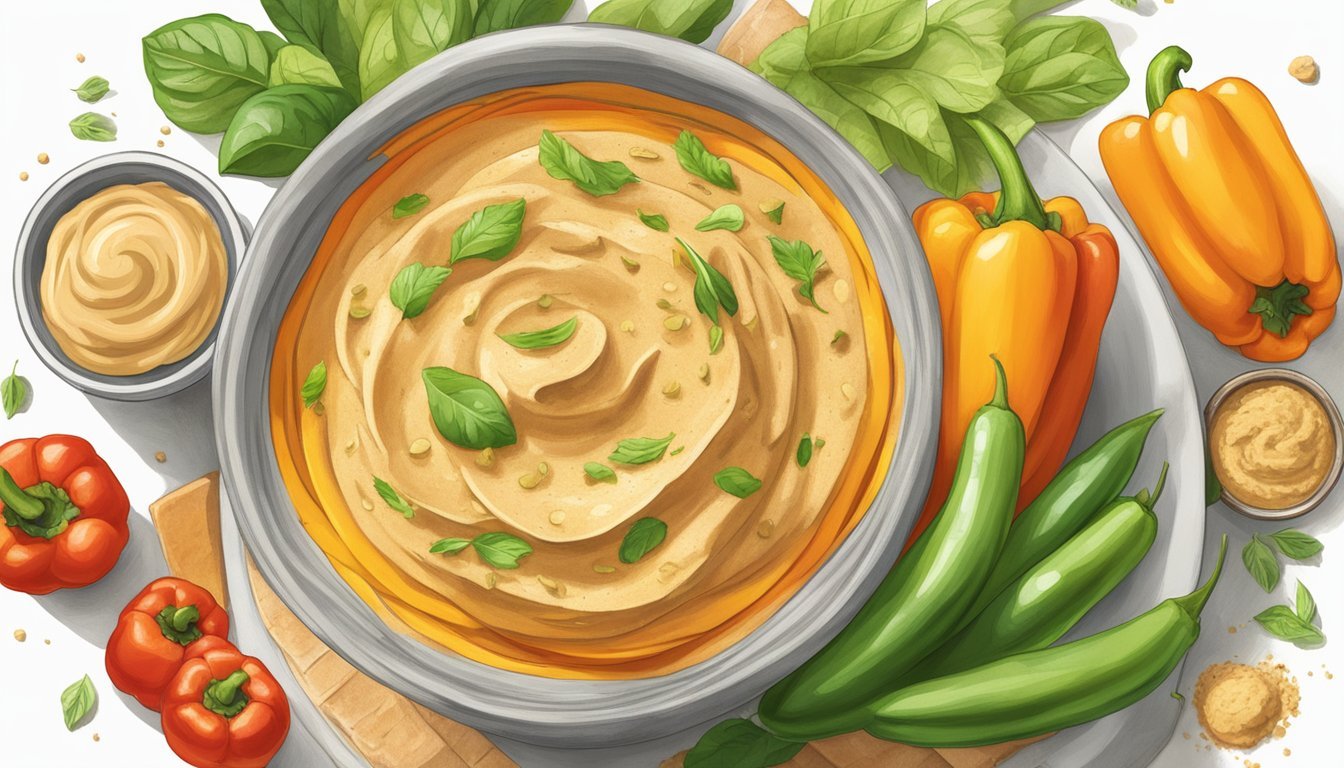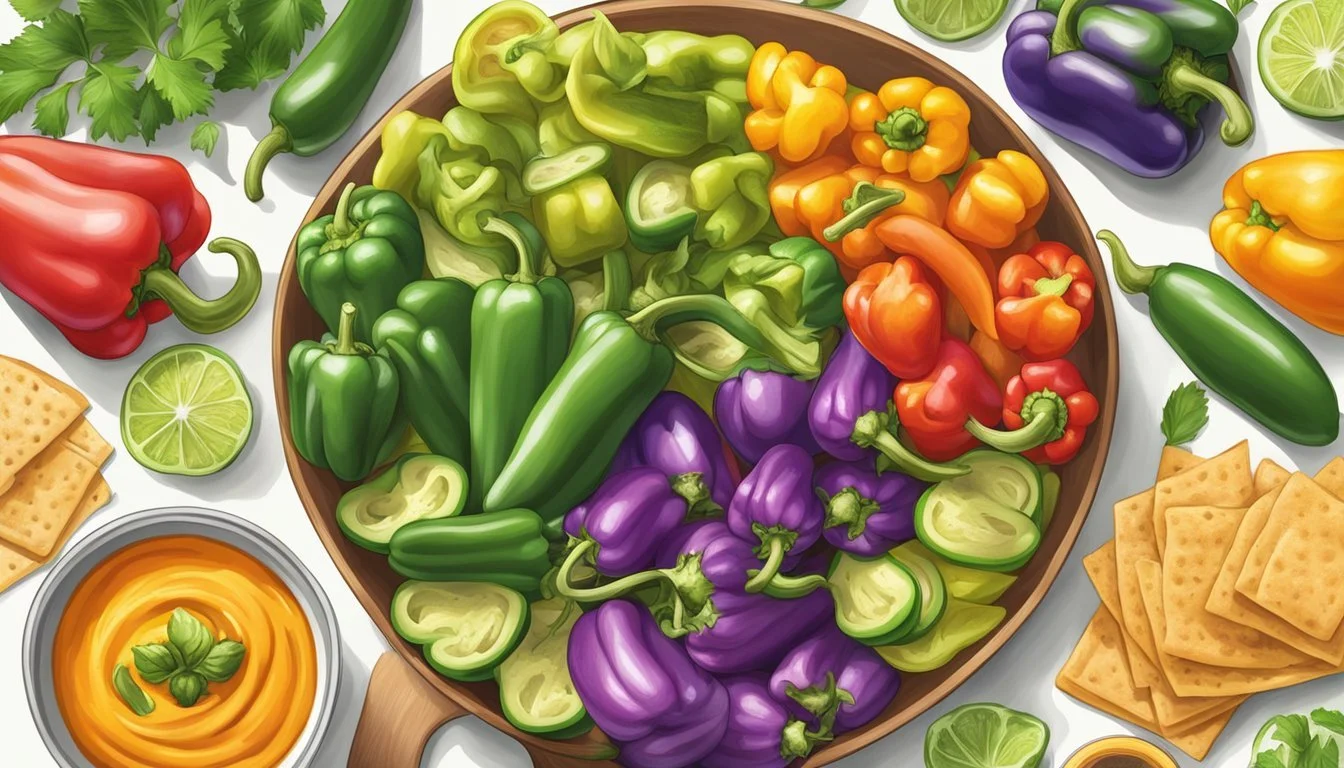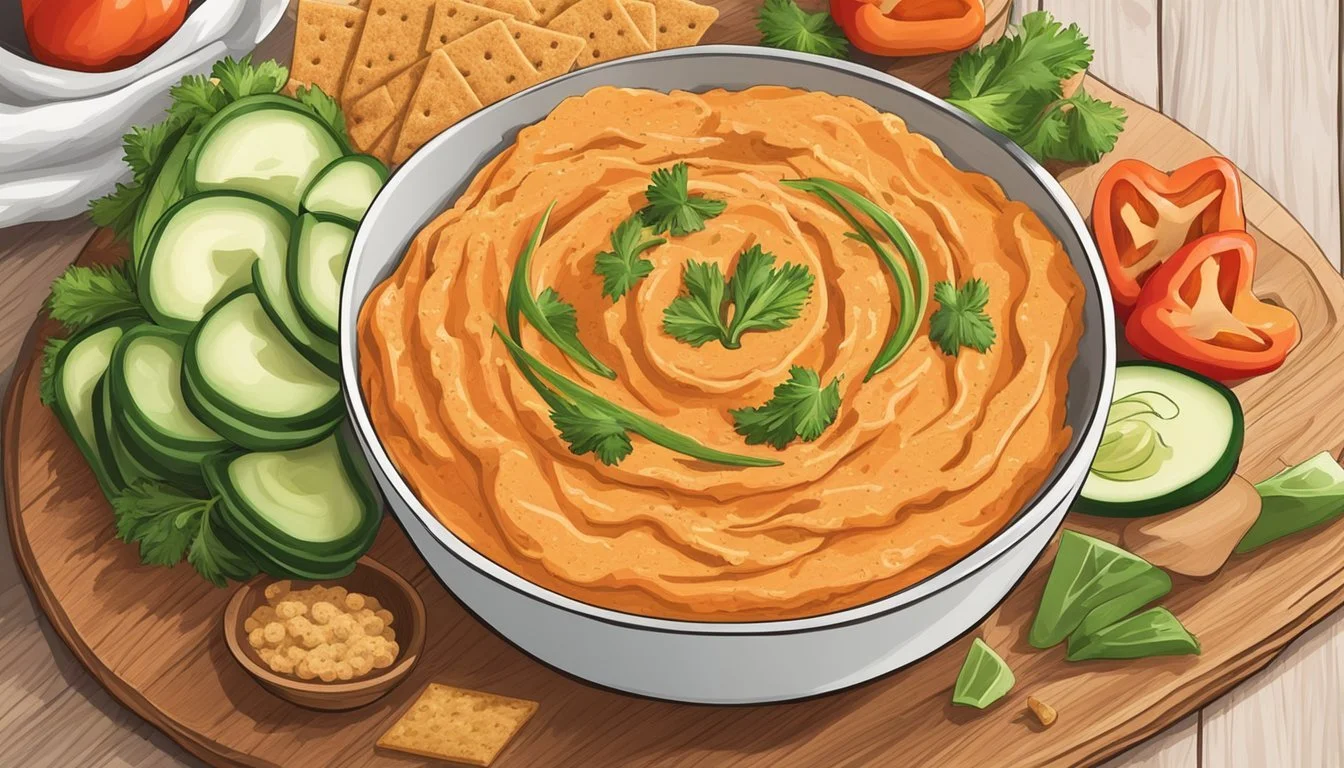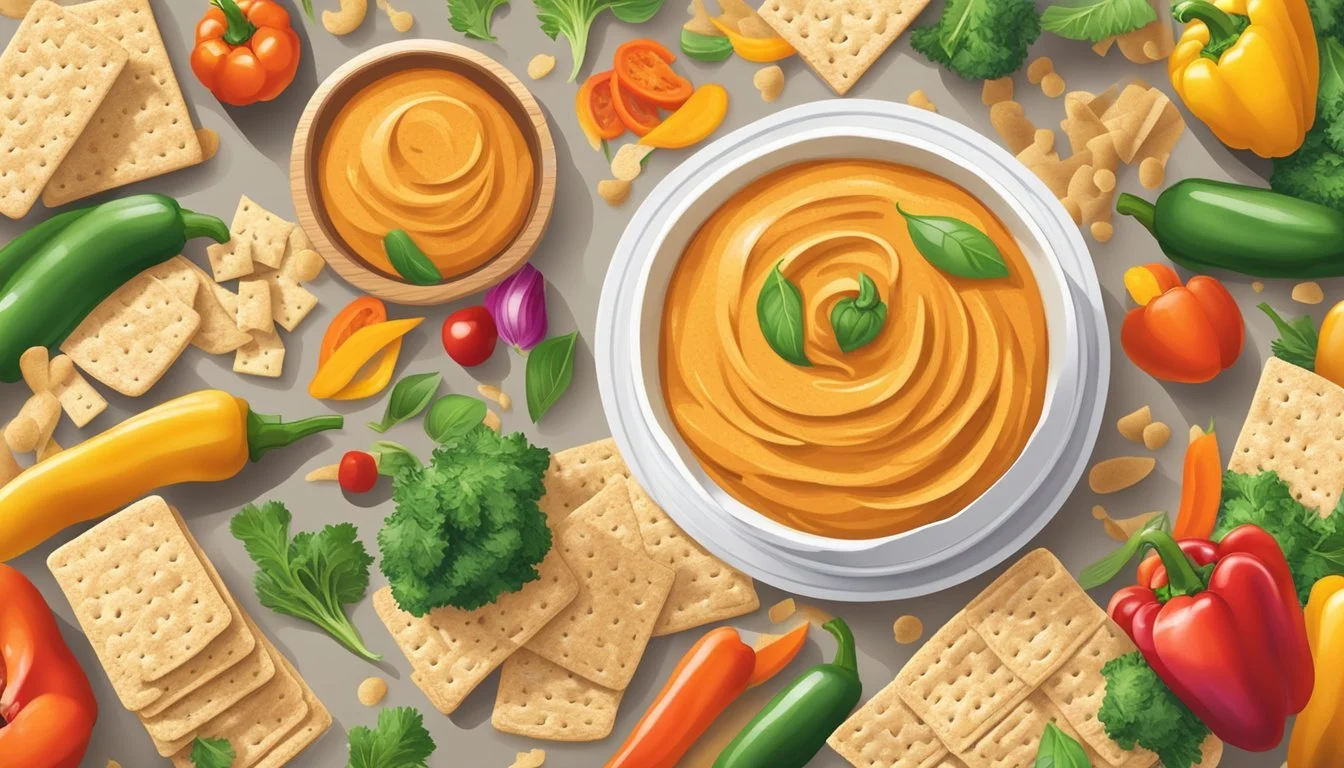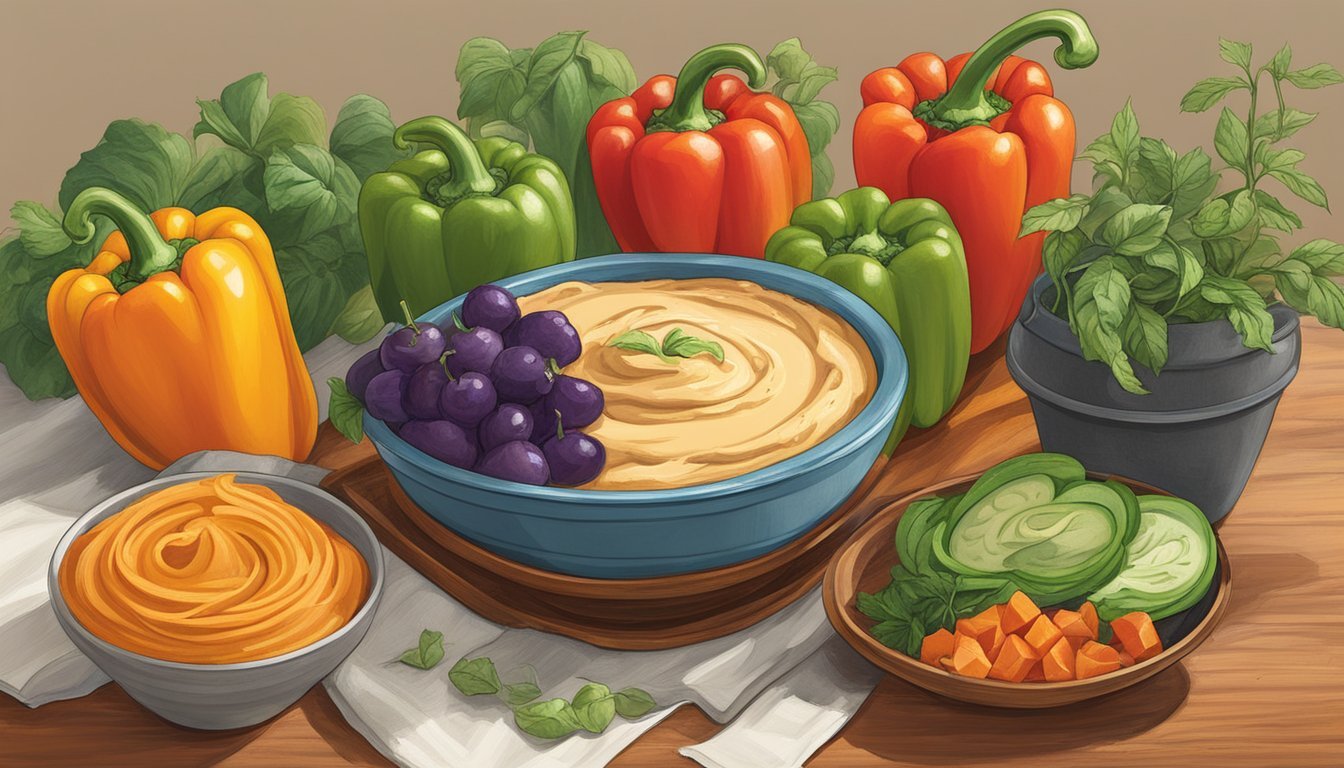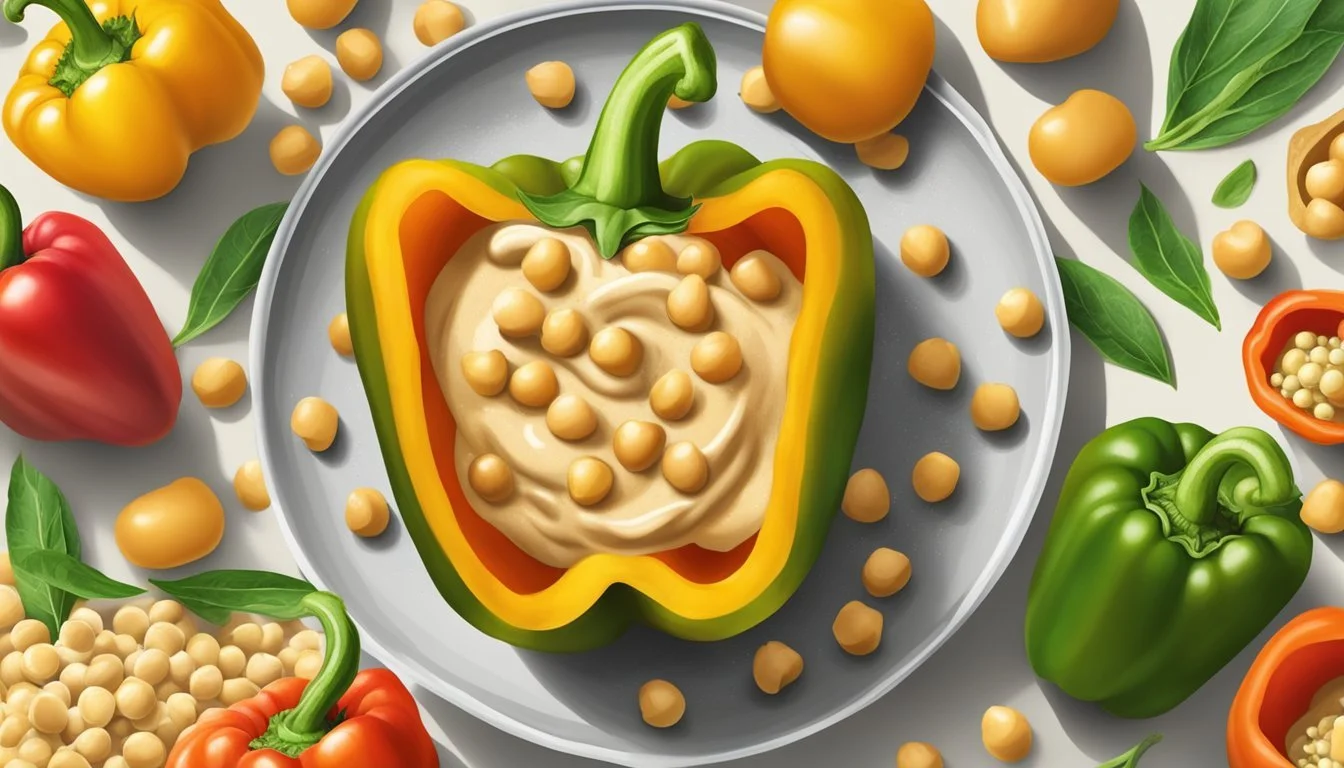Bell Pepper Core Hummus
The Ultimate Guide to a Vibrant, Nutrient-Packed Snack
Hummus has long been celebrated as a staple of healthy and savory snacking. Originating from the Middle East, it has gained worldwide acclaim not just for its creamy texture and versatility, but also for its nutritional profile. Rich in plant-based protein and fiber, hummus offers a satiating experience that supports digestive health and provides lasting energy. As interest in healthful eating continues to grow, innovative variations of this classic dip emerge, with bell pepper core hummus emerging as a colorful and fiber-rich variant.
Integrating bell peppers (What wine goes well with bell peppers?) into hummus not only enhances the dip's nutritional value but also adds a vibrant visual appeal and a subtle sweetness that complements the traditional flavors of tahini and chickpeas. Bell peppers come loaded with vitamins, especially vitamin C, and further boost the fiber content, making this version of hummus even more appealing for those seeking out a health-conscious snack.
The process of creating bell pepper core hummus involves roasting the peppers to intensify their flavor and to achieve a smoky depth that pairs exceptionally well with the creamy base of the hummus. The roasting also facilitates the blending of the peppers into the dip, ensuring a smooth texture that's perfect for spreading or dipping. Whether served cold or at room temperature, bell pepper hummus stands out as a wholesome and tantalizing option for anyone looking to elevate their snack game.
Exploring the Basics of Hummus
Hummus is a versatile, nourishing spread known for its creamy texture and rich flavors which are fundamental to many diets worldwide.
Historical Background
Hummus has its roots in the Middle East, where it has been a staple for centuries. This simple yet hearty dish consists primarily of mashed chickpeas, with historical evidence suggesting its consumption in ancient Egypt. Over the years, hummus has become integral to cuisines across the region and has gained international fame for its taste and versatility.
Health Benefits of Hummus
One of the main draws of hummus is its numerous health benefits. Rich in protein and fiber, hummus can contribute to muscle health and digestive well-being. Its ingredients, such as chickpeas, olive oil, and tahini, offer a variety of nutrients beneficial for overall health. Hummus is often included in vegan diets as a substantial source of plant-based protein.
Key Ingredients and Their Nutritional Value
Ingredient Nutritional Value Chickpeas High in protein and fiber, supporting muscle health and digestion. Tahini Rich in healthy fats and contains minerals like phosphorus and manganese. Olive Oil Contains monounsaturated fats, known for heart health benefits. Lemon Juice High in vitamin C, essential for a healthy immune system. Garlic Known for its antibacterial properties and ability to reduce inflammation.
Together, these key ingredients blend not just flavors but also nutrition to create a dish that's as wholesome as it is delicious. When vegetables like bell peppers are added to hummus, they not only enhance the flavor but also contribute additional fiber and vitamins, further increasing its nutritional profile.
Bell Peppers: A Versatile Vegetable
Bell peppers bring a burst of color and an array of nutrients to any recipe, making them an ideal component for a fiber-rich hummus. They enrich the dip with vitamins and minerals, enhancing both its health profile and flavor.
Nutritional Profile of Bell Peppers
Bell peppers stand out in the veggie world for their rich vitamin and mineral content. They are an excellent source of vitamin A, which is vital for eye health and a strong immune system, and vitamin C, known for its antioxidant properties and support to the immune system.
Fiber: A cup of chopped raw bell peppers contains about 3 grams.
Vitamins: A medium bell pepper is packed with vitamin A and also a significant amount of vitamin C.
Minerals: They contain potassium, folate, and iron.
Choosing the Right Bell Peppers for Hummus
When selecting bell peppers for hummus, look for firm, brightly colored peppers with tight skin. Freshness is key, as it affects both the taste and nutritional value.
Color: Red, yellow, and orange peppers are sweeter, adding a rich flavor profile to the hummus.
Texture: Choose bell peppers that feel heavy for their size, indicating a good moisture content.
Preparation Techniques for Bell Peppers
To incorporate bell peppers into hummus, they must first be properly prepared. Roasting is a popular technique that deepens their flavor while still maintaining a good portion of their nutrient content.
Roasting: Heat oven to 425 degrees Fahrenheit, place halved and seeded bell peppers skin side up, and roast until the skin darkens.
Cleaning: After roasting, remove the skin and any remaining seeds to ensure a smooth texture for the hummus.
Incorporating bell peppers into a hummus recipe contributes to a snack that is not only visually appealing and flavorful but also packed with nutritional benefits, making it a healthy choice for anyone, including those following a vegan diet.
Mastering the Recipe
Perfecting Bell Pepper Core Hummus requires careful attention to detail, specifically the selection of quality ingredients and the execution of precise steps. Below is a guide to obtaining a fiber-rich, flavorful dip with a vibrant, appealing presentation.
Ingredient List
Chickpeas: 1 can (15 oz), drained and rinsed
Tahini: 1/4 cup, for creaminess
Lemon Juice: 3 tablespoons, freshly squeezed for brightness
Garlic: 2 cloves, minced
Olive Oil: 2 tablespoons, plus extra for garnish
Red Bell Pepper: 1 large, core removed and roasted
Salt: 1/2 teaspoon, or to taste
Cayenne Pepper: 1/4 teaspoon, for a mild kick
Paprika: 1/2 teaspoon, for color and subtle sweetness
Cumin: 1 teaspoon, ground
Jalapeno: Optional, 1 tablespoon, chopped for added heat
Step-by-Step Instructions
Roast Red Bell Peppers: Preheat oven to 400°F (200°C). Slice the red bell pepper lengthwise, removing the core and seeds. Place on a baking sheet, drizzle with olive oil, and roast until skin blisters, turning occasionally.
Blend Chickpeas and Tahini: In a food processor, blend chickpeas and tahini for 1 minute, stop to scrape sides, and process for another 30 seconds to achieve a smooth mixture.
Add Flavor Elements: To the food processor, add roasted red bell pepper, minced garlic, lemon juice, salt, and spices. Blend until all ingredients are well combined and the hummus has reached a creamy consistency.
Adjust and Garnish: Taste and adjust seasoning, adding more salt or cayenne pepper if desired. Transfer the hummus to a serving bowl, garnish with a drizzle of olive oil, and a sprinkle of paprika.
Recipe Variations and Flavor Enhancers
Herbs: Add fresh herbs like parsley or cilantro to introduce a refreshing element.
Onion: Include a small amount of caramelized onion for added depth.
Vegan Protein: Integrate cooked quinoa or hemp seeds to boost protein content.
Spices: Experiment with additional spices such as coriander or za'atar for complexity.
Texture: For extra crunch, top with toasted pine nuts or chickpeas.
Serving and Pairing Suggestions
Bell Pepper Core Hummus not only brings a vibrant color to the table but also packs a nutritious punch of fiber. This section offers practical tips for serving this appetizing dip and pairing it with a variety of foods to enhance its flavors and textures.
Ideal Accompaniments
Vegetables: The crispness of raw veggies complements the smooth texture of the hummus. Suggested vegetables include:
Cucumbers: Slices or sticks for a refreshing crunch.
Tomatoes: Wedges or cherry tomatoes for a juicy burst.
Carrots: Baby carrots or sticks for a sweet and earthy note.
Bell Peppers: Strips of various colors for a sweet and crunchy addition.
Avocado: Cubes or slices for a creamy contrast.
Breads and Crackers:
Pita Bread: Warm wedges that are soft on the inside and slightly crisp on the edges.
Pita Chips: Crunchy chips, either plain or flavored, for a satisfying bite.
Crackers: A variety of whole grain crackers for added texture.
Tortillas: Mini tortilla rolls can serve as vehicles for a twist on veggie wraps.
Others:
Bell Pepper Core Hummus can be a versatile component in a sandwich or as a healthy snack option when paired with an assortment of other appetizers.
Serving Sizes and Presentation
When considering serving sizes for Bell Pepper Core Hummus, one should aim for about 2-4 tablespoons per person if served as part of a larger appetizer platter. For individual servings or as the main snack, increase the amount as needed.
Presentation Suggestions:
Use a wide bowl or a platter to allow easy access for dipping.
Garnish with a sprinkle of diced bell peppers on top for added color and texture.
Serve the hummus surrounded by the accompaniments in an appealing and accessible layout to encourage guests to create their own veggie hummus combinations.
Storage and Shelf Life
Proper storage of Bell Pepper Core Hummus maximizes its freshness and extends its shelf life, whether one opts for homemade or store-bought varieties. This dip's vibrant color and dietary fiber content make it not only a nutritious choice but also a meal prep favorite.
Proper Refrigeration
For homemade Bell Pepper Core Hummus, it is strongly advised to store it in the refrigerator immediately after preparation. In the fridge, homemade hummus remains fresh for up to 7 days. On the other hand, store-bought hummus often comes with preservatives that extend its shelf life. After opening, store-bought hummus should also be refrigerated, typically keeping for about 7 days.
Here are key storage tips for refrigeration:
Store in airtight containers to maintain freshness.
Keep at consistent refrigerator temperatures of 40°F or below.
Placement in the fridge matters; store on shelves rather than the door to avoid temperature fluctuations.
Freezing and Thawing Tips
Both homemade and store-bought Bell Pepper Core Hummus can be frozen, though texture changes could occur. When freezing, consider the following:
Portion hummus into smaller containers or ice trays for easier thawing.
Use heavy-duty freezer bags or airtight containers to prevent freezer burn.
Label with a date to ensure the product is used within optimal freshness, which is typically 2-3 months for the best quality.
To thaw, one should:
Allow the hummus to slowly defrost in the refrigerator.
Avoid microwaving or exposing it to heat, as this could result in uneven thawing and potential spoilage.
Nutritional Considerations and Dietary Adjustments
When creating Bell Pepper Core Hummus, it's essential to consider the caloric content, macronutrient profile, and dietary needs. This colorful twist on traditional hummus can be tailored to various dietary preferences while offering a nutrient-dense option.
Calorie Count and Macronutrient Balance
A serving of Bell Pepper Core Hummus typically contains a balanced mix of macronutrients. The primary components are:
Protein: Chickpeas and tahini provide protein, essential for muscle repair and growth.
Fiber: High in fiber due to both the bell peppers and chickpeas, contributing to digestive health.
Fats: Contains heart-healthy unsaturated fats from olive oil and tahini.
A typical serving size (approximately 2 tablespoons) may include:
Calories: 70-100 (varies with ingredients)
Protein: 2-3g
Fiber: 2-4g
Fats: 5-8g (predominantly unsaturated)
Sugar: Approximately 4g (mostly natural sugars from bell peppers)
Adapting the Recipe for Special Diets
Bell Pepper Core Hummus can be easily adapted for different dietary needs:
Vegan: Naturally vegan, as it contains no animal products.
Gluten-Free: Inherently gluten-free, making it suitable for those with gluten intolerances.
Dairy-Free: Does not include dairy, perfect for lactose-intolerant individuals.
Oil-Free Option: For an oil-free version, cooks can omit olive oil and use aquafaba (chickpea brine) to achieve a creamy consistency.
Reduced Sugar: Although naturally low in sugar, one can reduce the sugar content further by selecting bell peppers that are lower in natural sugars.
By adjusting ingredient proportions or substituting components, individuals can create a Bell Pepper Core Hummus that aligns with their dietary preferences and restrictions while still enjoying a flavorful and nutritious dip.
Advanced Tips and Tricks
In this section, the focus is on refining the art of making Bell Pepper Core Hummus to achieve not only a perfect blend of flavors but also an inviting presentation and versatile applications.
Achieving the Perfect Texture
To create a silky-smooth Bell Pepper Core Hummus, one must consider the appliance used. A high-speed blender can yield a creamier texture, while a food processor provides a bit more control over the consistency. For optimal smoothness, add olive oil or a little water during blending to adjust the hummus to the desired consistency. Lemon juice not only brightens the flavor but also aids in smoother blending when added in gradual increments.
Appliance Texture Result Blender Creamier Food Processor Adjustable Consistency
Enhancing with Toppings and Garnishes
A spoonful of roasted red pepper hummus on top adds a vibrant contrast and depth in flavor. Chopped parsley, chives, and dill can be sprinkled as garnishes for a fresh herby note. To finish, a generous drizzle of extra virgin olive oil provides richness and decorates the surface with a glossy sheen.
Suggested Garnishes:
Fresh herbs: Parsley, Chives, Dill
Oils: A swirl of Olive Oil
Creative Uses Beyond Dipping
Bell Pepper Core Hummus is not limited to being a dip. It can be repurposed as a nutritious spread for veggie wraps, adding both moisture and flavor. To enhance a wrap, spread a thick layer of hummus, then add your choice of vegetables. The hummus acts as a flavor enhancer and helps hold the wrap together.
Ideas for Hummus in Dishes:
Spread for Veggie Wraps
Base for a Mediterranean-inspired pizza
Beyond the Dip: Expanding Your Culinary Horizons
While Bell Pepper Core Hummus is a staple dip, it can also transform meals with its rich flavor and nourishing ingredients. This section illuminates its versatility beyond the bowl, revealing how it can become the star in both main courses and snacks.
Integrating Hummus into Main Courses
Bell Pepper Core Hummus elevates the experience of vegan meals and provides a creamy, nutrient-dense element to dinner and lunch dishes. Here are specific ways to incorporate it into your meal planning.
Stuffed Vegetables:
Zucchini: Slice zucchini in half and hollow out a canal. Fill with a mixture of Bell Pepper Core Hummus, diced mushrooms, and spinach. Bake until tender.
Bell Peppers: Remove tops, deseed, and fill with a blend of hummus and quinoa. Top with shredded cabbage for extra crunch and bake.
Hummus-Infused Wraps & Sandwiches:
Wraps: Spread hummus on whole-wheat tortillas, add falafel balls, kale, and sliced cucumber, and roll up for a hearty lunch.
Sandwiches: Use hummus as a flavorful spread on multigrain bread. Layer with grilled vegetables like eggplant and zucchini for a satisfying meal.
Innovative Snack Ideas
Hummus can be the foundation of creative snack concoctions — offering a protein-rich alternative paired with various textures and flavors.
Lettuce Cups: Fill crisp lettuce leaves with a spoonful of Bell Pepper Core Hummus. Top with edamame and a sprinkle of sesame seeds for a quick and refreshing bite.
Hummus Topped Crudités: Arrange a colorful selection of vegetable sticks — carrots, celery, and bell peppers — and dollop with hummus. Optionally, add a dash of chili flakes for a spicy kick.
In these applications, Bell Pepper Core Hummus isn't just an accompaniment; it's a transformative ingredient that can make everyday meals and snacks more vibrant and nutritious.
Seasonal and Local Variations
In crafting a Bell Pepper Core Hummus, incorporating seasonal and local ingredients can significantly enhance not just the flavor profile but also the nutritional value of the dip. Summer brings a bounty of fresh produce that can be utilized to create vibrant versions of this classic dish.
Summer Specials
During the summertime, tomatoes and cucumbers are at their peak, offering a fresh taste and a burst of color to the hummus. One can blend ripe tomatoes to add a tangy twist or dice them up for a chunky texture. Cucumbers provide a crisp freshness and can be finely chopped and mixed into the hummus for a refreshing spin. For those who enjoy a bit of heat, incorporating a spicy element like sriracha sauce or freshly minced jalapeños adds a flavorful kick, pairing exceptionally well with the sweetness of bell peppers.
Summer Specials Ingredients:
Ripe tomatoes (blended or diced)
Fresh crisp cucumbers (finely chopped)
Spicy elements (sriracha or minced jalapeños)
Utilizing Local Produce
Chefs and home cooks alike lean on local produce to elevate their hummus. By choosing local bell peppers, they ensure maximum flavor and support regional agriculture. Local farmers often grow a variety of bell peppers, ranging from the traditional red, yellow, and green to more unique purple and chocolate hues, providing an array of flavors and colors for the hummus. Additionally, one should look for other local veggies such as garlic, onions, and fresh herbs to blend into the hummus for an amplified taste of the region.
Local Ingredients to Consider:
Variety of bell peppers (red, yellow, green, purple, chocolate)
Local veggies (garlic, onions)
Fresh herbs (specific to region)
The Environmental Footprint of Hummus Production
The environmental impact of hummus production is influenced by the sourcing of ingredients and the choices between homemade and store-bought products.
Sourcing Sustainable Ingredients
When it comes to the environmental footprint of hummus production, one crucial aspect is sourcing ingredients sustainably. Bell peppers, a significant component in bell pepper hummus, vary in their carbon footprint. Data indicates that bell peppers have a carbon footprint of 0.73 kg CO2e per pound. A substantial portion of this footprint—approximately 80%—originates from the growing phase due to land usage and high maintenance. The carbon emission is further influenced by factors such as transportation if the peppers are not local.
Chickpeas, another primary ingredient, have a generally lower environmental impact. Efforts by companies to encourage local farming of chickpeas can reduce emissions associated with long-distance transport. Additionally, consumers can look for sustainable certifications and select organic or local produce to reduce their hummus's environmental impact.
Homemade vs. Store-Bought Impact
The choice between homemade hummus and store-bought hummus also plays a role in the environmental impact. Homemade hummus often has a lower footprint, chiefly due to the absence of industrial processing and packaging. When consumers make hummus at home, they can control ingredient sourcing, such as using local and organic bell peppers and chickpeas, thereby minimizing the transportation emissions.
In contrast, store-bought hummus often involves mass production techniques and comes packaged in plastics or other materials that contribute to waste. The energy used for producing, packaging, and distributing these products includes both direct emissions from greenhouse heating and indirect emissions from electricity consumption, marking it as an environmental hot spot.
Consumers concerned with sustainability might prefer homemade hummus, which allows for more eco-friendly choices and reduces the overall environmental impact. However, not all store-bought options are equal, and it is possible to find brands that prioritize sustainable practices.

